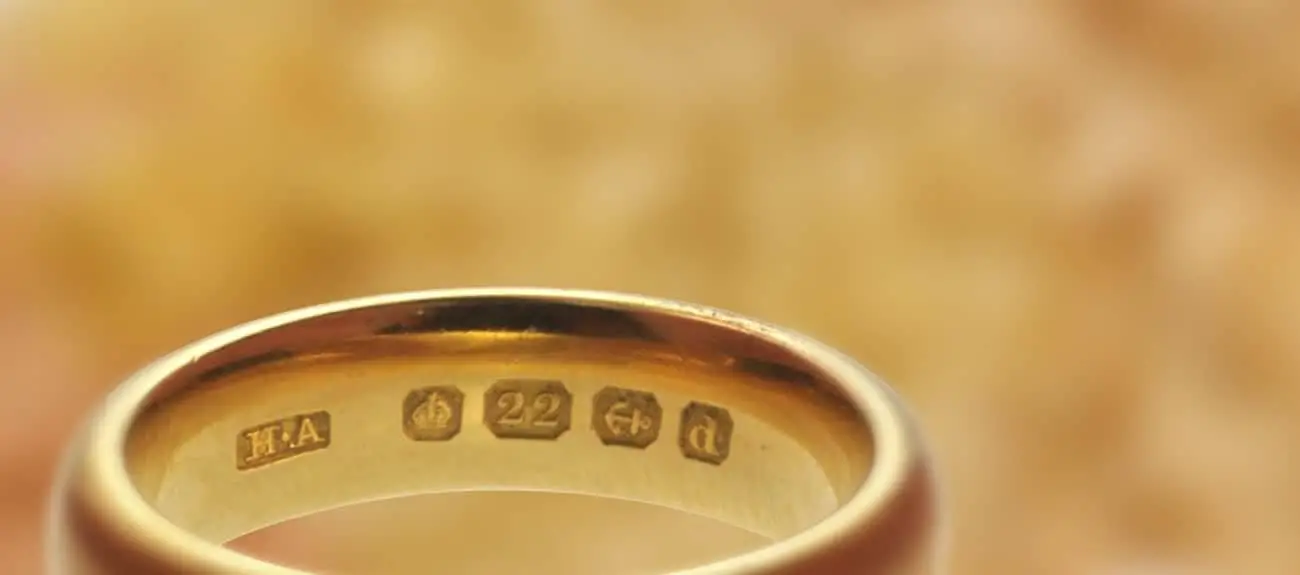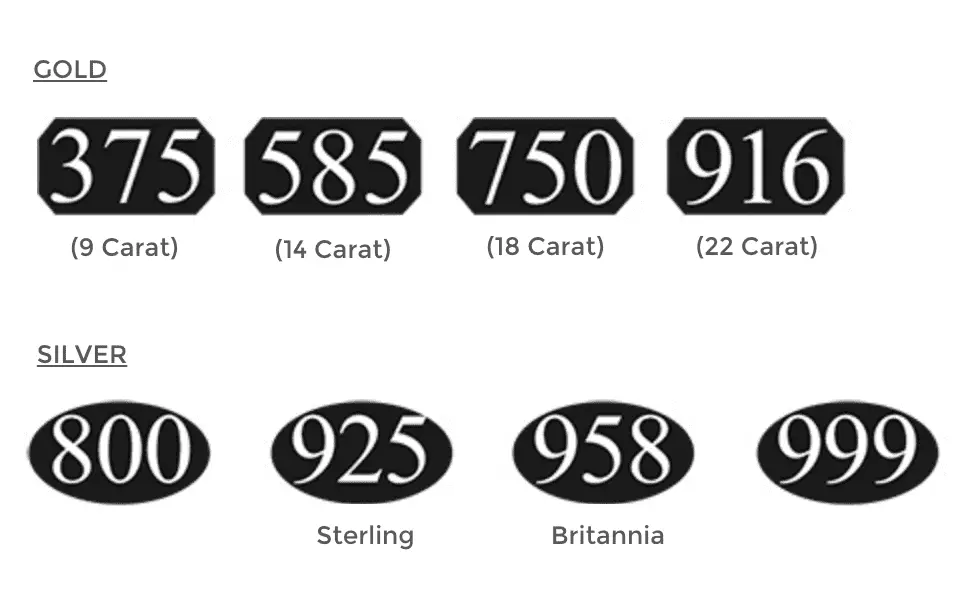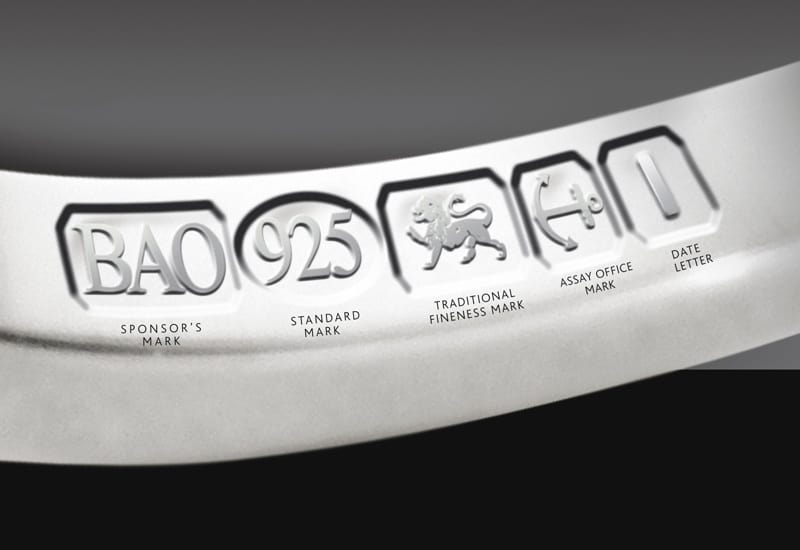Table of Contents
Despite having been around for millennia, there is a lot that is misunderstood about precious metals. There are few elements of precious more commonly misunderstood, yet so fundamentally important, as hallmarks.
*This post may contain affiliate links. As an Amazon Associate we earn from qualifying purchases.
No, we’re not talking about sappy birthday cards. Hallmarks are critical components of precious metals. Given their very high economic value, it is important to verify every precious metal product or bullion that you own. For this, precious metals hallmarks do exactly that.
Put briefly, hallmarks are official marks engraved on items made from precious metals. They are used to signify the purity of the metal, and to guarantee the fineness of the material. In many jurisdictions, they are required by law to curb fraudsters or counterfeiters.
Unfortunately, we live in a world that requires us to be extra vigilant about our financial assets. While fraudsters exist across all industries, the precious metal economy is especially vulnerable. Internet vendors are notorious for selling counterfeit bullion such as fake gold bars and coins.
Thankfully, there are several methods to reduce the risk of fraud.
For one, you can ensure the legitimacy of an item by only buying and selling on trusted exchanges. One of the most trusted precious metal markets is the London Bullion Market Association (LBMA). Since it is backed by the Bank of England, you can rest assured that you’re getting an authentic product. The Hard Assets Alliance (HAA) also sell bullion ensured by the LBMA.
Another way to safeguard against fraud is to check your precious metals hallmarks. Since many metals can appear indistinguishable to the naked eye—such as white gold, platinum, and palladium—hallmarks are crucial for distinguishing between them. Once purchased, the only guarantee of authenticity is to carefully check the hallmark.
But if you are confused by the tiny engravings on your bullion, know that you’re not alone. Many buyers, veterans and first-timers alike, are thrown off by the inscriptions. If you want to find out more about precious metals hallmarks, and how to read them properly, then check out our in-depth guide below.
To see the most popular kits for testing your precious metals just click here.
Hallmarks 101
The art of hallmarking began in the Middle Ages as a primitive form of consumer protection. Medieval kingdoms started to demand banks to inscribe the value and identification of gold and silver articles so that consumers would be shielded from inauthentic vendors.
Today, hallmarked metals ensure that the bullion has been tested and that it conforms to all the legal requirements used to signify purity. The practice is now widespread, and those caught selling non-hallmarked metals are often subjected to harsh criminal penalties.
However, in most cases, metals sold in increments less than 7.8 grams are not subject to hallmarking requirements.
Essentially, hallmarks are a series of small engravings. However, to the untrained eye they can be confusing and nearly impossible to interpret. There are also many kinds of hallmarks and, in turn, many ways of identifying them.
As one would expect, a hallmark meaning, and appearance will vary by the precious metal in question.
Recognizing Hallmarks
Over the past couple of decades, hallmarks have become standardized across many countries. This makes their interpretation much easier than it was before. Here is a quick breakdown of the modern varieties of precious metals hallmarks.
The Sponsor’s Mark
The Sponsor’s Mark is one of three compulsory hallmarks on precious metals. Essentially, this mark indicates the “make” of the bullion. In other words, it indicates the entity responsible for sending the article to the Assay Office that oversees all hallmarking regulations.
In most countries, anyone can send their metals to the Assay Office to receive a Sponsor’s Mark, including individual hobbyists and collectors. There is a nominal fee for this service, and it is usually considered the bare minimum hallmarking expectation for proving inspection.
Occasionally, Sponsor’s Marks can be found depicting brand names or company logos.
The Standard Mark
The second engraving is typically the Standard Mark. This hallmark indicates the purity and fineness of the precious metal. The notation used is parts per thousand (ppt), which tells the buyer the percentage of pure silver, gold, or platinum in the bullion.
The Standard Mark will be surrounded by a geometrical shape that indicates the specific variety of metal it’s engraved upon. The list below contains each of the Standard Mark shapes that are used in the hallmarking of precious metals.
- Sterling silver = Oval
- Gold = Oblong with corners removed OR Hexagon
- Platinum = Trapezoid
- Palladium = Three (3) connected circles
The Assay Mark
Sometimes referred to as the “town mark”, the Assay Mark indicates which Assay Office approved of the item. This hallmark holds little relative importance to the buyer when compared to the former two. However, since there are many Assay Offices throughout the world, it is important for verification purposes to know which one has recognized the item.
Optional Hallmarks
Some precious metals hallmarks are purely voluntary. These can act as additional assurances against fraud, or simply tell you more about the product itself. There are three (3) common hallmarks that are not mandated by law, making them strictly voluntary.
A “date letter” mark depicts the year that the article was tested and approved by the Assay Office. These involve the use of alphabetical letters to indicate the month, with “A” standing in for January.
A pictorial mark is becoming increasingly rare on modern-day bullion. Traditionally, picture engravings such as a woman’s head or the body of a lion were included on sterling silver marks and certain gold pieces.
Lastly, commemorative marks are used to draw attention to significant world events that occur around the time of engraving. For example, in the United Kingdom, the Diamond Jubilee symbol was included among silver hallmarks in 2012.
Hallmarks by Metal Type
There are some variations in the appearance, presentation, and regulation of hallmarks according to metal type. To review, it is important to remember the following key differences across the precious metals hallmarks.
The gold symbol on the Standard Mark is identified by a Hexagon shape in many jurisdictions, or occasionally it is depicted by an oblong shape with the corners cut out. By contrast, the silver symbol on the Standard Mark is a plain oval, and platinum is a trapezoid in the shape of a house.
Oftentimes, imported bullions have different kinds of hallmarks that stand in for the Standard Mark. These vary widely by country, so it is important to do independent research from trusted sources if you come across an imported bullion that has an unusual Standard Mark.
Hallmark Exemptions
A little-known fact about precious metals hallmarks is that small items do not require them. However, the threshold weight varies by individual metal type. Use the guide below to discover what size of each metal is exempt from compulsory hallmarking.
Those metals weighing less than the following amount will, in most cases, not carry a hallmark:
- Gold = less than 1 gram
- Silver = less than 7.8 grams
- Platinum = less than 0.5 grams
- Palladium = less than 1 gram
Don’t Fall for It
There are many common scams committed against those who don’t have a very strong grasp of precious metals hallmarks. Luckily for you, we’ve broken each of them down in detail so that you won’t get caught off guard.
When you call certain bullion dealers, it’s common for salesmen to try to sell you superfluous products. Unless you’ve consulted with your financial advisor, we strongly advise against purchasing futures contracts or insurance plans from independent vendors.
Another common scam is committed by fraudulent “cash-for-gold” shops that prey on those who are inexperienced in the industry. In these cases, shops will examine your bullion’s hallmark and claim that it is faked, even if it is completely authentic. This is a common excuse that predatory store owners will use to pay pennies on the dollar for perfectly legit precious metals.
When you buy gold Exchange Traded Funds (ETFs) such as the SPDR Long Dollar Gold Trust, it is important to know that you do not actually own any precious metals at all. Rather, you own several stocks in companies that work within the precious metals industry. This is an important distinction that may first-time buyers are not informed of.
More intricate scam artists will attempt to confiscate your gold or silver. Sometimes they will use the excuse that the metals have not been adequately hallmarked. This is a lie, and you must never allow your precious metals to be given over to them.
Report suspicious behavior such as this to local authorities.
Lastly, when it comes to the precious metals trade, eBay is a scammer’s paradise. Many counterfeit bullions are sold on online exchanges, and many are in increments so low that they do not legally require hallmarking. It is strongly advised to avoid these vendors, as there is no guarantee that the product you receive will be authentic.




